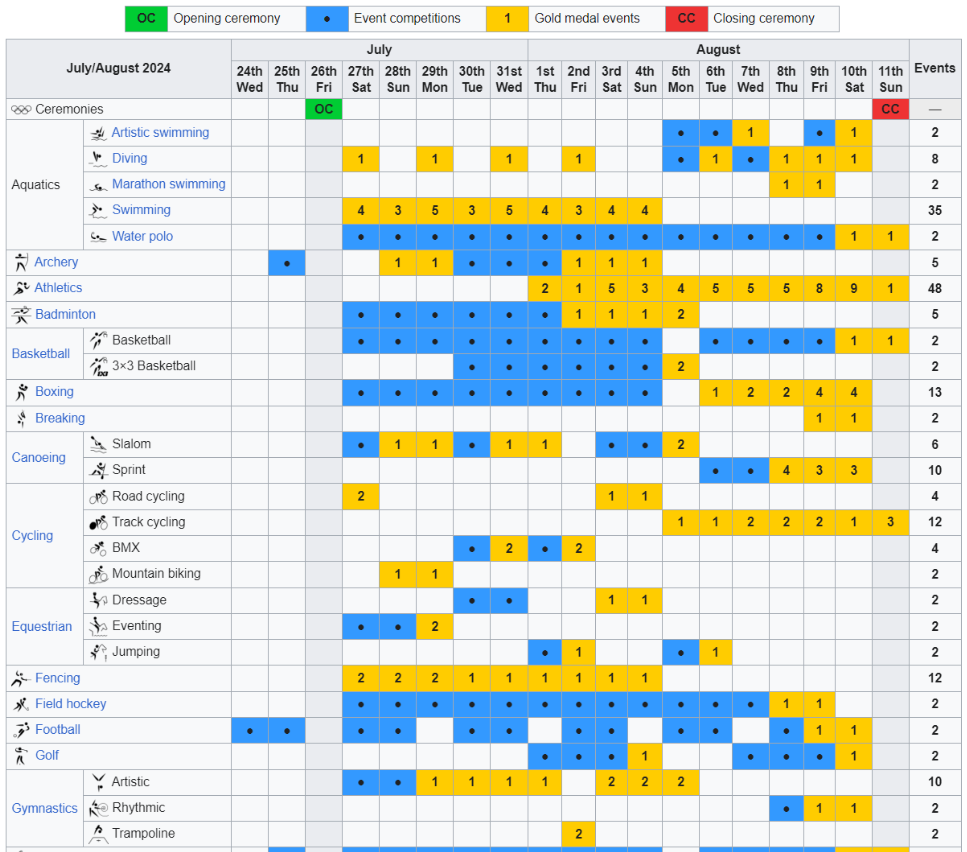Summer Olympics Schedule: Breaking At The Summer Olympics Schedule

The Summer Olympics schedule is a complex and carefully crafted plan that encompasses a multitude of sporting events over a period of several weeks. It is designed to provide a captivating experience for athletes, spectators, and viewers worldwide, showcasing the pinnacle of athletic achievement.
Summer Olympics Schedule Structure
The Summer Olympics schedule follows a structured format, typically consisting of three main phases: the opening ceremony, the competitions, and the closing ceremony.
- Opening Ceremony: The opening ceremony marks the official start of the Games, usually featuring a grand spectacle that highlights the host city’s culture and history. It is a time for athletes from all participating nations to come together in a spirit of unity and sportsmanship.
- Competitions: The heart of the Games lies in the competitions themselves, where athletes compete in a diverse range of sports, striving for Olympic glory. These competitions are spread over several weeks, with each sport having its own schedule.
- Closing Ceremony: The closing ceremony signifies the end of the Games, with a celebration of the athletes’ achievements and a handover of the Olympic flag to the host city of the next Games.
Summer Olympics Sporting Events
The Summer Olympics feature a wide array of sporting events, categorized into different disciplines, each representing a unique aspect of athletic skill and prowess.
- Aquatics: This category encompasses swimming, diving, synchronized swimming, and water polo, showcasing the athletes’ mastery of water sports.
- Archery: This ancient sport involves the use of bows and arrows, testing the athletes’ precision and focus.
- Athletics: This category encompasses track and field events, including sprints, hurdles, jumps, throws, and marathons, showcasing the athletes’ speed, power, and endurance.
- Badminton: This racket sport involves two opposing players or two opposing pairs, testing the athletes’ agility, reflexes, and strategic prowess.
- Basketball: This team sport involves two teams of five players, showcasing the athletes’ teamwork, ball-handling skills, and shooting accuracy.
- Boxing: This combat sport involves two athletes competing in a ring, showcasing their strength, agility, and strategic boxing techniques.
- Canoeing/Kayaking: This water sport involves paddling a canoe or kayak, showcasing the athletes’ strength, endurance, and paddling skills.
- Cycling: This category encompasses road cycling, track cycling, mountain biking, and BMX, showcasing the athletes’ speed, endurance, and technical skills.
- Equestrian: This category encompasses dressage, show jumping, eventing, and endurance riding, showcasing the athletes’ horsemanship and athletic skills.
- Fencing: This combat sport involves two athletes using swords, showcasing their agility, speed, and strategic fencing techniques.
- Football (Soccer): This team sport involves two teams of eleven players, showcasing the athletes’ teamwork, ball-handling skills, and goal-scoring ability.
- Golf: This individual sport involves striking a ball into a series of holes on a golf course, showcasing the athletes’ precision, strategy, and swing techniques.
- Gymnastics: This category encompasses artistic gymnastics, rhythmic gymnastics, and trampoline gymnastics, showcasing the athletes’ strength, flexibility, and coordination.
- Handball: This team sport involves two teams of seven players, showcasing the athletes’ teamwork, ball-handling skills, and goal-scoring ability.
- Hockey: This category encompasses field hockey and ice hockey, showcasing the athletes’ teamwork, stick-handling skills, and goal-scoring ability.
- Judo: This combat sport involves two athletes competing on a mat, showcasing their strength, agility, and grappling techniques.
- Karate: This martial art involves the use of punches, kicks, and blocks, showcasing the athletes’ speed, power, and precision.
- Modern Pentathlon: This multi-discipline sport involves fencing, swimming, riding, shooting, and running, showcasing the athletes’ versatility and athleticism.
- Rowing: This water sport involves rowing a boat, showcasing the athletes’ strength, endurance, and rowing techniques.
- Rugby Sevens: This team sport involves two teams of seven players, showcasing the athletes’ teamwork, ball-handling skills, and goal-scoring ability.
- Sailing: This water sport involves sailing a boat, showcasing the athletes’ navigation skills, wind knowledge, and boat handling techniques.
- Shooting: This sport involves shooting targets with firearms, showcasing the athletes’ precision, accuracy, and focus.
- Skateboarding: This action sport involves riding a skateboard, showcasing the athletes’ balance, agility, and technical skills.
- Sport Climbing: This sport involves climbing artificial walls, showcasing the athletes’ strength, agility, and climbing techniques.
- Surfing: This water sport involves riding waves on a surfboard, showcasing the athletes’ balance, wave knowledge, and surfing skills.
- Table Tennis: This racket sport involves two opposing players, showcasing the athletes’ agility, reflexes, and strategic prowess.
- Taekwondo: This martial art involves the use of punches, kicks, and blocks, showcasing the athletes’ speed, power, and precision.
- Tennis: This racket sport involves two opposing players or two opposing pairs, showcasing the athletes’ agility, reflexes, and strategic prowess.
- Triathlon: This multi-discipline sport involves swimming, cycling, and running, showcasing the athletes’ versatility and athleticism.
- Volleyball: This team sport involves two teams of six players, showcasing the athletes’ teamwork, ball-handling skills, and spiking ability.
- Weightlifting: This sport involves lifting weights, showcasing the athletes’ strength, power, and lifting techniques.
- Wrestling: This combat sport involves two athletes competing on a mat, showcasing their strength, agility, and grappling techniques.
Summer Olympics Key Dates and Times
The Summer Olympics schedule is subject to change, but here are some key dates and times for major events:
| Event | Date | Time |
|---|---|---|
| Opening Ceremony | Insert Date | Insert Time |
| Insert Sport Final | Insert Date | Insert Time |
| Insert Sport Final | Insert Date | Insert Time |
| Insert Sport Final | Insert Date | Insert Time |
| Closing Ceremony | Insert Date | Insert Time |
Breaking into the Spotlight

Breaking, a vibrant dance form born on the streets, has taken the world by storm, transitioning from a street culture phenomenon to a recognized sport and finally securing a place in the prestigious Summer Olympics. This journey highlights the evolution of breaking, its growing popularity, and its well-deserved recognition as a dynamic and captivating athletic art form.
The Evolution of Breaking
Breaking, with its roots firmly planted in the Bronx borough of New York City in the 1970s, emerged as a unique expression of urban culture. It gained popularity through its connection with hip-hop music, graffiti art, and DJing, forming the core elements of this influential cultural movement. Breaking evolved from spontaneous battles in the streets to organized competitions, attracting a growing community of passionate dancers who honed their skills and pushed the boundaries of this dynamic dance form.
Judging Criteria in Breaking Competitions
Breaking competitions are judged by a panel of experienced dancers who assess various elements, including:
* Technique: This encompasses the dancer’s control, fluidity, and precision in executing various breaking moves, such as toprock, footwork, power moves, and freezes.
* Musicality: The ability to interpret the rhythm and beat of the music, showcasing creativity and improvisation in response to the musical cues.
* Creativity: Originality in move combinations, the ability to express a unique style, and the incorporation of personal flair into the performance.
* Performance: The overall stage presence, energy, and charisma exhibited by the dancer, engaging the audience with their passion and storytelling through movement.
The scoring system in breaking competitions typically involves awarding points based on the performance’s overall quality, technical proficiency, musicality, creativity, and stage presence.
Comparing Breaking with Other Dance Forms
| Feature | Breaking | Hip-Hop Dance | Contemporary Dance |
|---|---|---|---|
| Origins | Street culture, Bronx, NYC | Street culture, influenced by funk, jazz, and soul | Modern dance, influenced by ballet and other forms |
| Style | Dynamic, athletic, improvisational, battles | Expressive, rhythmic, influenced by urban culture | Lyrical, fluid, emotionally driven, focus on storytelling |
| Music | Hip-hop, funk, electronic music | Hip-hop, R&B, soul, funk | Classical, contemporary, electronic, ambient |
| Costumes | Streetwear, comfortable for movement | Streetwear, expressive attire | Flowing, minimalist, expressive garments |
Analyzing Breaking at the Olympics

Breaking, a dynamic and expressive dance form, made its Olympic debut at the Tokyo 2020 Games, marking a significant milestone for the urban dance culture. This introduction of breaking into the Olympic stage has brought with it a surge of interest and excitement, prompting an analysis of the key factors and trends shaping the sport’s future within the global sporting landscape.
Top Breaking Athletes and their Strategies, Breaking at the summer olympics schedule
The breaking scene boasts a diverse array of talented athletes, each with unique styles and competitive approaches. Here are some of the prominent figures who have shaped the landscape of breaking at the Olympics:
- B-Boy V.S. (USA): Known for his innovative footwork and dynamic power moves, V.S. is a consistent contender in international competitions. His strategic approach involves balancing technical prowess with creative expression, often incorporating elements of surprise into his routines.
- B-Girl Shaniqua (USA): A pioneer in the female breaking scene, Shaniqua is renowned for her intricate footwork and dynamic spins. Her competitive strategy focuses on showcasing technical mastery while maintaining a captivating stage presence.
- B-Boy Lil Zoo (France): Lil Zoo’s unique blend of power moves and intricate footwork has earned him international recognition. His strategic approach involves incorporating elements of surprise and unpredictability, keeping his opponents on their toes.
Breaking’s Impact on the Olympic Games
The inclusion of breaking in the Olympic Games has introduced a new dimension to the sporting spectacle, attracting a younger audience and promoting inclusivity.
- Attracting a Younger Audience: Breaking’s vibrant energy and youthful appeal have proven effective in engaging a younger demographic, bringing a fresh perspective to the Olympic Games. The sport’s dynamic nature and visual spectacle resonate with a generation accustomed to fast-paced entertainment, potentially attracting a new wave of viewers and participants.
- Promoting Inclusivity: Breaking, as an art form deeply rooted in urban culture, embodies principles of diversity and inclusivity. Its accessibility, regardless of background or physical attributes, promotes a sense of belonging and encourages participation from a wide range of individuals. The inclusion of breaking in the Olympics reflects a broader shift towards celebrating diversity and inclusivity within the sporting world.
Timeline of Breaking at the Olympics
Breaking’s journey to the Olympic stage has been marked by significant milestones, culminating in its official inclusion in the Tokyo 2020 Games.
- 2018: Breaking was officially recognized as a sport by the International Olympic Committee (IOC).
- 2019: The first Olympic qualifying events for breaking were held, with athletes from around the world competing for a chance to represent their countries at the Tokyo Games.
- 2020: Breaking made its Olympic debut at the Tokyo 2020 Games, with 16 male and 16 female breakers competing for gold.
Breaking at the summer olympics schedule – The summer Olympics, a spectacle of athletic prowess and international unity, often feels like a fragile truce, a momentary respite from the world’s tensions. The echoes of the ancient Games, however, are often overshadowed by the stark realities of the modern world, like the long-standing conflict between Iran and Israel , which cast a long shadow on the Olympic spirit.
Even as athletes compete for glory, the ghosts of history linger, reminding us that the pursuit of peace and understanding is a constant struggle, much like the arduous training regimen of an Olympian.
The summer Olympics, a spectacle of athletic prowess, can be a whirlwind of emotions. The constant schedule of events, the pressure to perform, the thrill of victory, and the sting of defeat, all converge into a dizzying dance. It’s a stark contrast to the simpler pleasures of childhood, like the excitement of collecting McDonald’s collector meal cups , each one a tiny treasure.
The Olympics may be a world of ambition and striving, but perhaps there’s a lesson in those childhood moments, a reminder that sometimes, the simplest joys are the most enduring.